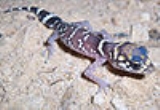
Underwoodisaurus milii
Encyclopedia
Underwoodisaurus milii is a species of Gekkonidae also classified as Nephrurus milii. It is commonly known as the thick-tailed or barking gecko. These names come from its distinctive plump tail and sharp, barking defensive call.
Unusually for reptiles, this species forms aggregations in their retreat sites during the day. The reasons for this are unknown. However, it has been shown that this behavior results in a higher aggregate thermal inertia (they stay warmer) than would be found in solitary geckos of this and related kinds in similar circumstances. In the same source, it was suggested that aggregating for physiological benefits may precede the development of other kinds of social behavior.
Their distribution in Western Australia
is throughout the southwest, the goldfields, wheatbelt, and nullarbor regions to the east, and to Shark Bay
in the north. They are also found at the Houtman Abrolhos
and the Archipelago of the Recherche
.
, nor the Australian EPBC Act, and may be kept as a pet with the appropriate license in at least some states of Australia.
Description
Thick-tailed geckos are reddish-brown with bands of white and yellow spots and paler underbelly. They usually grow to 120-140 mm in length. Their original tail is black with several pale bands, however regenerated tails have little pattern. When threatened, they will arch their backs and "bark". Thick-tailed geckos are found in rocky outcrops across southern Australia, and are slightly more cold-tolerant than many other Australian gecko species. They are nocturnal, and shelter underneath rocks or in burrows during the day. They feed on insects and small vertebrates.Unusually for reptiles, this species forms aggregations in their retreat sites during the day. The reasons for this are unknown. However, it has been shown that this behavior results in a higher aggregate thermal inertia (they stay warmer) than would be found in solitary geckos of this and related kinds in similar circumstances. In the same source, it was suggested that aggregating for physiological benefits may precede the development of other kinds of social behavior.
Behaviour
This species, and some other species of gecko have the unusual habit of licking their eyes after eating, presumeably to keep the eyeshield clean.Distribution
They are found in southern regions of the Australia.Their distribution in Western Australia
Western Australia
Western Australia is a state of Australia, occupying the entire western third of the Australian continent. It is bounded by the Indian Ocean to the north and west, the Great Australian Bight and Indian Ocean to the south, the Northern Territory to the north-east and South Australia to the south-east...
is throughout the southwest, the goldfields, wheatbelt, and nullarbor regions to the east, and to Shark Bay
Shark Bay, Western Australia
Shark Bay is a World Heritage Site in the Gascoyne region of Western Australia. It is an area centred approximately on , 800 kilometres north of Perth, on the westernmost point of Australia. An expedition led by Dirk Hartog happened upon the area in 1616, becoming the second group of Europeans...
in the north. They are also found at the Houtman Abrolhos
Houtman Abrolhos
The Houtman Abrolhos is a chain of 122 islands, and associated coral reefs, in the Indian Ocean off the west coast of Australia. Nominally located at , it lies about eighty kilometres west of Geraldton, Western Australia...
and the Archipelago of the Recherche
Archipelago of the Recherche
Archipelago of the Recherche is a group of 105 islands, and over 1200 "obstacles to shipping", off the southern coast of Western Australia. The islands, also known as the Recherche Archipelago, stretch from East to West and to off-shore....
.
Conservation status
The species has not been assessed for the IUCN Red ListIUCN Red List
The IUCN Red List of Threatened Species , founded in 1963, is the world's most comprehensive inventory of the global conservation status of biological species. The International Union for Conservation of Nature is the world's main authority on the conservation status of species...
, nor the Australian EPBC Act, and may be kept as a pet with the appropriate license in at least some states of Australia.

